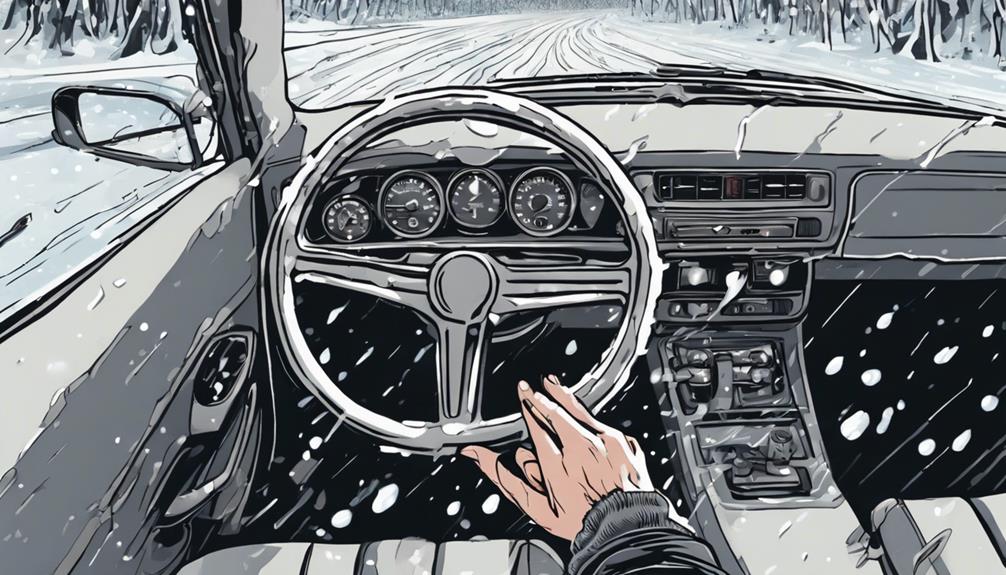Surviving Winter Road Trips: A Comprehensive Guide
Imagine embarking on a winter road trip is like navigating a treacherous icy path. As you set out on your journey, the road ahead may be fraught with challenges that require careful consideration and preparation. From snowy conditions to unexpected black ice, each turn presents its own set of obstacles.
But fear not, this comprehensive guide will equip you with the knowledge and tools needed to conquer the winter roads. Prepare yourself for a safe and smooth journey ahead.
Understanding Winter Driving Hazards
Prepare yourself for the challenges of winter driving by understanding the common hazards you may encounter on the road. One crucial aspect to consider is winter tire requirements. In many regions, using winter tires isn't just a suggestion but a legal requirement during the colder months.
Winter tires are specifically designed to provide better traction in snow and ice, enhancing your vehicle's ability to grip the road and reducing the likelihood of skidding. Make sure your tires are in good condition and properly inflated before embarking on your winter journey.
Another significant hazard to be mindful of is driving during blizzards. Blizzards bring heavy snowfall, strong winds, and poor visibility, making roads extremely treacherous. If you find yourself caught in a blizzard while driving, the best course of action is to pull over at a safe location, turn on your hazard lights, and wait until conditions improve.
Avoid unnecessary risks by staying informed about weather forecasts and road conditions before heading out. Remember, your safety should always be the top priority when facing extreme winter weather conditions like blizzards. By understanding these hazards and taking necessary precautions, you can better prepare yourself for a safe winter road trip.
Tips for Driving in Snow
When navigating snowy roads, ensure your vehicle's headlights are on for increased visibility and safety. Driving in snow requires extra caution and specific techniques to ensure a safe journey. Here are some essential tips for driving in snow:
- Maintain a Safe Braking Distance: The snowy and icy roads reduce the effectiveness of your brakes. Increase your following distance to allow for more time to stop safely. Gentle braking prevents skidding and helps maintain control of your vehicle.
- Use Traction Control Systems: If your vehicle is equipped with traction control, make sure it's turned on. Traction control helps prevent wheel spin on slippery surfaces, improving your vehicle's stability and grip on the road.
- Drive Smoothly and Steadily: Avoid sudden movements such as quick acceleration, sharp turns, or abrupt braking. Smooth and gradual actions are key to maintaining traction and control in snowy conditions.
Dealing With Ice on Roads
Navigating through icy roads requires a different set of precautions compared to driving in snow. When facing icy conditions, ensuring your vehicle is equipped with winter tires is crucial. Winter tires have a deeper tread and are designed to provide better traction on icy surfaces, offering increased stability and control.
Before hitting the road, it's essential to clear any ice from your car windows using proper ice scraping techniques. Make sure all windows, mirrors, and lights are completely clear for optimal visibility. Additionally, de-icing sprays or solutions can be helpful in quickly removing ice from your windshield and windows. It's also important to check your vehicle's anti-freeze levels to prevent the engine from freezing in cold temperatures.
While driving on icy roads, maintain a safe distance from other vehicles and drive at a reduced speed to allow for ample reaction time. Be cautious when approaching intersections, bridges, and shaded areas where ice tends to accumulate. If you encounter black ice, avoid sudden braking or sharp turns to prevent skidding.
Navigating Fog and Reduced Visibility
Ensuring clear visibility while driving through foggy conditions is essential for safe navigation on the road. When encountering fog, follow these tips to stay safe:
- Use fog lights: Switch on your vehicle's fog lights to increase your visibility to other drivers and help you see the road ahead better.
- Reduce speed: Slow down to give yourself more time to react to any obstacles or sudden changes in the road conditions.
- Maintain a safe distance: Increase the following distance between you and the vehicle in front of you to avoid collisions in case of sudden stops.
Fog can significantly reduce visibility, making it challenging to spot other vehicles, pedestrians, or potential hazards on the road. By taking these precautions and using your fog lights effectively, you can enhance your safety while driving in foggy conditions.
Handling Strong Winds on Highways
To navigate safely through strong winds on highways, adjust your driving technique to maintain control of your vehicle and stay on course. Windy conditions can pose a challenge, but by taking necessary precautions, you can ensure highway safety even amidst wind turbulence.
When faced with strong winds, it's crucial to keep a firm grip on the steering wheel. Be prepared for sudden gusts by holding the wheel with both hands, especially if you're driving a high-profile vehicle like an SUV or a truck. These vehicles are more susceptible to being pushed off course by strong winds.
Reduce your speed to give yourself more time to react to sudden gusts and maintain stability. Slowing down can also minimize the impact of wind turbulence on your vehicle, helping you stay in your lane and avoid swaying.
Stay alert and be aware of your surroundings. Look out for large vehicles like trucks and buses, as they can create wind tunnels that may affect your vehicle. Keep a safe distance from them and be cautious when passing or being passed by these vehicles.
Preparing for Freezing Rain
When faced with freezing rain during your winter road trip, prioritize checking your vehicle's tires and brakes for optimal performance. Freezing rain can create extremely hazardous driving conditions, so taking precautions is crucial to ensure your safety on the road. Here are some essential steps to prepare for freezing rain:
- Carrying chains: In areas prone to freezing rain, having tire chains in your vehicle can provide extra traction and help prevent skidding on icy roads. Make sure you know how to properly install them before your trip.
- Defrosting windows: Before setting off, ensure all your windows are completely defrosted. Use your vehicle's defroster and a good ice scraper to clear all windows, mirrors, and lights for maximum visibility.
- Check windshield wipers: Ensure your windshield wipers are in good condition and replace them if needed. Properly functioning wipers are essential for maintaining visibility during freezing rain.
Coping With Black Ice

Navigating through black ice requires heightened awareness and quick reflexes to maintain control of your vehicle on the slick, invisible patches of ice. Black ice precautions are crucial to ensuring your safety on winter roads. To cope with this treacherous condition, start by reducing your speed and increasing your following distance. This gives you more time to react if you encounter black ice. Keep a firm grip on the steering wheel and avoid sudden movements that could cause your vehicle to slide.
Ice-free driving techniques are essential when dealing with black ice. One key technique is to avoid sudden braking. Instead, gently apply the brakes and steer in the direction you want to go. If you feel your vehicle starting to slide, remain calm and steer into the skid to help regain control. It's also important to refrain from using cruise control when black ice is a concern, as it can make it harder to react quickly to changing road conditions.
Roadside Assistance and Emergency Kits
Prepare for unexpected roadside emergencies by ensuring you have a well-stocked emergency kit in your vehicle. Having the right supplies can make a significant difference in critical situations during your winter road trips.
Here are three essential items to include in your emergency kit:
- Tire Chains: These are crucial for providing traction in snowy or icy conditions. If you encounter a slippery road, tire chains can help improve your vehicle's grip and stability, allowing you to navigate through challenging terrain more safely.
- Jumper Cables: Cold weather can take a toll on your vehicle's battery, increasing the chances of it dying unexpectedly. Jumper cables are a lifesaver in such situations, enabling you to jump-start your car with the help of another vehicle. Make sure you know how to use them correctly.
- First Aid Kit: Accidents can happen anytime, and having a well-equipped first aid kit can be invaluable. Stock it with essentials like bandages, antiseptic wipes, pain relievers, and any necessary medications. Be prepared to handle minor injuries until help arrives.
Frequently Asked Questions
How Can I Prevent My Car's Windows From Fogging up While Driving in Winter Conditions?
To keep your car windows from fogging up in winter, try using defrosting techniques like turning on your heater and directing the airflow to the windshield.
You can also apply anti-fog solutions to the inside of the windows. These methods will help clear up the fog quickly and improve visibility while driving in winter conditions.
Stay safe and fog-free on your winter road trips!
Are There Any Special Precautions I Should Take When Driving on Bridges or Overpasses During Winter?
When driving on bridges or overpasses during winter, take special precautions. These areas can freeze faster than regular roads due to the road elevation. Be aware of black ice, which is hard to spot and can cause your vehicle to lose traction.
Slow down and increase your following distance to stay safe. Keep an eye out for warning signs or reports of icy conditions on bridges and overpasses.
What Should I Do if I Encounter a Snowplow on the Road While Driving in Snowy Conditions?
If you encounter a snowplow on the road during snowy conditions, remember snowplow etiquette. Keep a safe distance, slow down, and never pass a snowplow. Be patient and allow the plow to clear the road ahead.
If you need assistance due to road conditions, consider contacting roadside assistance for help. Stay alert and drive cautiously to ensure your safety and the safety of others on the road.
How Can I Safely Navigate Through a Whiteout While Driving in a Winter Storm?
When driving through a whiteout in a winter storm, preparation is key. Make sure you have emergency supplies like blankets and snacks in your car.
Slow down and turn on your hazard lights to increase visibility. Stay focused on the road and avoid sudden movements.
If possible, pull over to a safe location until conditions improve. Safety should always be your top priority when navigating through challenging winter weather.
Is It Safe to Use Cruise Control While Driving on Icy Roads During the Winter?
When driving on icy roads during winter, using cruise control isn't safe. You need to have full control of your vehicle at all times, especially in slippery conditions.
Engine braking can help you slow down without losing traction, and traction control systems are designed to assist in maintaining stability on icy roads.
Avoid using cruise control to react quickly to changing road conditions and stay safe during winter driving.
Conclusion
Overall, surviving winter road trips requires preparation, caution, and adaptability.
By understanding the various hazards that come with winter driving, such as snow, ice, fog, and strong winds, you can better navigate the roads.
Make sure to have a roadside assistance plan and emergency kit in case of unexpected situations.
With these tips in mind, you can safely reach your destination and enjoy your winter adventures.
Stay safe out there!
